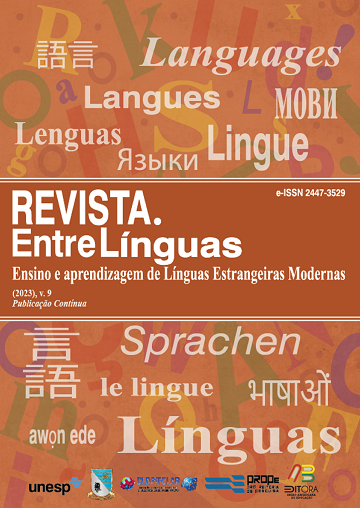A naive picture of the world and a biosemantic approach to describing the lexical structure of a word
DOI :
https://doi.org/10.29051/el.v9i00.17640Mots-clés :
Biosemiotics, Meaning, Polysemy, Cognitive linguistics, Lexical invariantRésumé
The problems of studying the lexical structure of a word have a way out into various areas of cognitive science, including biosemiotics. In the article, the biosemiotic approach is reframed into a biosemantic approach based on decoding specific lexical structures. The lexical invariants of polysemous words are shown to be meaningful cores of their figurative meanings. It is a set of dominant semantic components that are stably associated with each lexeme’s meaning. In the process of semiosis, the individual is guided by these invariant components. These components are formed over time in the individual's cognitive niche as a result of observations of the relationship between language signs. The practical part of the article includes an empirical invariant-component analysis of the English polysemous substantive “a hood” from the standpoint of invariant semantics. Given the results, biosemiotics has an advantage over traditional semantics in describing the semantics of lexical units.
Téléchargements
Références
ALVES, F.; JAKOBSEN, A. L. (Eds.). The Routledge handbook of translation and cognition. Abingdon and New York: Routledge. 2021.
ANDREWS, E. Semiotic principles in cognitive neuroscience. Cognitive and Intermedial Semiotics, p. 1-10, 2019.
CARRERA-CASADO, D.; FERRER-I-CANCHO, R. The advent and fall of a vocabulary learning bias from communicative efficiency. Biosemiotics, v. 14, n. 2, p. 345-375, 2021.
ENDARA, L. et al. Building the “Plant glossary” - a controlled botanical vocabulary using terms extracted from the floras of North America and China. Taxon, v. 66, n. 4, p. 953-966, 2017.
KULL, K. The biosemiotic fundamentals of aesthetics: beauty is the perfect semiotic fitting. Biosemiotics, v. 15, n. 1, p. 1-22, 2022.
MATTHIESSEN, C. M. et al. Cognition in systemic functional linguistics. In: Systemic Functional Insights on Language and Linguistics. Singapore: Springer Singapore, 2022. p. 147-195.
MENANT, C. Constraint satisfaction, agency and meaning generation as an evolutionary framework for a constructive biosemiotics. In: Agency and Meaning Generation as an Evolutionary Framework for a Constructive Biosemiotics, 17 Feb. 2019.
NOVIKOV, D. N.; PESINA, S. A. Biosemiotics and Prototype Semantics in Understanding Lexical Polysemy: Implications for Applied Linguistics. The magic of innovation. New techniques and technologies in teaching foreign languages, v. 275, 2015.
PELKEY, J. Chiastic antisymmetry in language evolution. The American Journal of Semiotics, v. 29, n.1/4, p. 39-68, 2016.
PESINA, S.; LATUSHKINA, O. Polysemy and Cognition. Procedia-Social and behavioral sciences, v. 192, p. 486-490, 2015.
PESINA, S. A.; YUSUPOVA, L. G.; PULEKHA, I. R. Anthropomorphism in language studied through the prism of embodiment. Вестник Челябинского государственного университета, v. 10, n. 432, p. 223-227, 2019.
SONESSON, G. Cognitive Science and Semiotics. Bloomsbury Semiotics, v. 4, p. 293-312, 2022.
TAKAHASHI, H. Cognitive Linguistics: SAGE Benchmarks in Language and Linguistics Ed. by Masa-aki Yamanashi, SAGE Publications, London, 2016, 1520pp. English Linguistics, v. 36, n. 1, p. 115-128, 2019.
ZHAI, Z. et al. Improving chemical named entity recognition in patents with contextualized word embeddings. 2019. arXiv preprint arXiv:1907.02679.
Téléchargements
Publiée
Comment citer
Numéro
Rubrique
Licence

Ce travail est disponible sous licence Creative Commons Attribution - Pas d’Utilisation Commerciale - Partage dans les Mêmes Conditions 4.0 International.
Os manuscritos aceitos e publicados são de propriedade da Revista EntreLínguas. Os artigos publicados e as referências citadas na Revista EntreLínguas são de inteira responsabilidade de seus autores.
Transferência de direitos autorais – autorização para publicação
Caso o artigo submetido seja aprovado para publicação, já fica acordado que o(s) autor(es) autoriza(m) a UNESP a reproduzi-lo e publicá-lo na EntreLínguas, entendendo-se os termos “reprodução” e “publicação” conforme definição respectivamente dos incisos VI e I do artigo 5° da Lei 9610/98. O artigo poderá ser acessado pela rede mundial de computadores (Internet), sendo permitidas, a título gratuito, a consulta e a reprodução de exemplar do artigo para uso próprio de quem a consulta, desde que haja a citação ao texto consultado. Essa autorização de publicação 328 EntreLínguas, Araraquara, v. 1, n .2, p. 323-328, jul./dez. 2015 não tem limitação de tempo, ficando a UNESP responsável pela manutenção da identificação do(s) autor(es) do artigo. Os artigos publicados e as referências citadas na Revista EntreLínguas são de inteira responsabilidade de seus autores.











